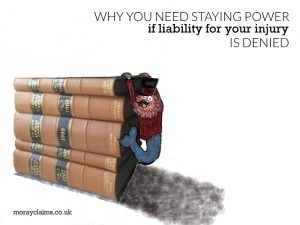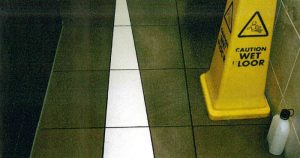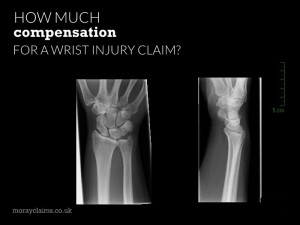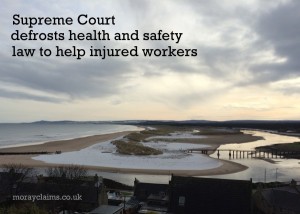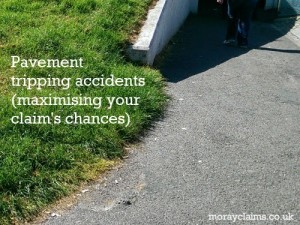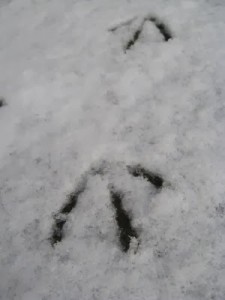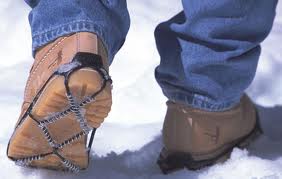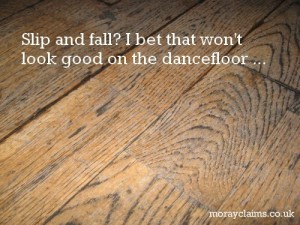This is a case study of an injury claim arising from a pavement tripping accident. We’ll go through the stages of the claim from intimation of claim to the point where insurers admitted liability. It was not a straightforward process. In our experience, that is not unusual. We hope this will give you an illustration of what can happen with a personal injury claim for tripping injuries. The facts show why perseverance with a claim may be necessary. Here’s a photo of the pavement where the injured person fell. At the time of the accident, the injured person was walking into the photo (i.e. away from the cameraman). The injured person's left foot went down on the edge of hole at a point where it was about 3cm deep. This caused them to go over on their left ankle and suffer an inversion injury to it. Scottish local authorities generally have a duty to repair pavement defects once they produce a height difference of more than 2cm (20mm). This is a height difference Continue Reading
Slipping accident on retail premises: a case study
Ms S visited a fast food restaurant in Elgin at the end of a night out. She needed to use the customer toilets. She went through the door from the restaurant into the ceramic-tiled corridor which led to the toilets. Though she did not notice the fact until after she had fallen, the floor was wet. This caused her to slip. As a result of her fall, she suffered an injury to her back. A "wet floor" sign was put out in the corridor, immediately following her accident. She reported her accident to a member of staff at the time but it was not until the next day that she realised the severity of the injury. She had the presence of mind to write a letter to the manager of the fast food restaurant informing him of the fact and details of her accident. Grigor & Young made a compensation claim on Ms S’s behalf, in this case. At all times, liability was denied. The fast food restaurant did not accept that, in fact, the floor had been wet at the time. They did not accept Continue Reading
Wrist Injury Claims
Elgin’s Dr Gray’s Hospital takes its name from Alexander Gray. He was born in Elgin but died in India in 1807, having spent over 20 years working as a surgeon for the East India Company. He had amassed quite a fortune and he bequeathed the bulk of his estate to his native town. The sum of £20,000 (probably equivalent to more than £1 million today) was allocated “for the establishment of a hospital … for the sick and the poor”. Gray’s next of kin contested the will and it was not until 1814 that a court declared the money to be free for use to buy a plot of ground on the west side of the town. Building went ahead from the following year and the (then, 30-bed) hospital opened on 01 January 1819. 1814 was an important year for the future practice of medicine in Moray but it was also an important year in the wider medical world. 1814 was also a significant year in relation to the diagnosis and treatment of wrist injuries. In 1814, Abraham Colles (1773–1843), an Irish surgeon who Continue Reading
Supermarket Slipping Accidents
Growing up in the U.S. in the middle of last century, Irving Naxon’s mother told him stories of her own childhood in a small village in Lithuania. Every Friday afternoon, she took a pot of uncooked stew to the local bakery, where it was placed in the oven. While everyone observed the Jewish Sabbath on the Saturday, the dish simmered in the slowly cooling oven. By evening, it was cooked to perfection and ready to be collected and eaten by the family. Naxon was inspired by this story and, throughout the 1950s and 1960s, sought to develop a way of cooking which was both economical and environmentally friendly. His invention was the Naxon Beanery – a pot surrounded by a heating element which mimicked the cooking method from the Eastern European bakery. The ‘slow cooker’ was born. When Naxon retired in 1971, he sold his business. The new owners refined the cooker’s design and renamed it the Crock Pot. Today, crock pots are integral to American cooking: they’re low-effort, efficient and Continue Reading
Slip On Ice At Work Case Clarifies Law On Workplace Personal Injury Claims
Imagine you're employed as a home carer in Scotland. Your work requires you to go out at all times of day and in all kinds of weather to provide personal care to the elderly, vulnerable and terminally-ill. One night in winter, with snow and ice lying on the ground, you slip and fall as you make your way to one of your client's homes. You break your wrist. The flat boots you were wearing had ridged soles but their grip was not enough to keep you upright. It turns out that crampon-like shoe attachments were available at reasonable cost and they would probably have prevented your fall if your employer had given you them to use. In other words, you can argue that your employer failed to take proper care for your safety, by failing to provide adequate personal protective equipment, so you have a right to claim compensation from them for your injuries and other losses. On the other hand, periodic sub-zero temperatures are a fact of life in northern Europe, aren't they? Anyone Continue Reading
Slip / Trip Accidents And Why The Location Matters
If you have ever fallen over, you’ll know that embarrassment is often the overwhelming feeling, at first. After a trip or slip in a public place - such as a busy supermarket, shopping centre or street – we will tend to pick ourselves up quickly and make as fast an exit as possible, even if we are hobbling on our way. An accident of this type may be a pure accident – no one’s fault but your own – such as a trip while you are walking and updating your Facebook status at the same time. Even a momentary distraction can be enough to cause a fall. On the other hand, if your fall is due to someone else’s negligence (such as the occupier of land or a local authority), you may be able to make a claim for compensation for personal injury. This article considers slip / trip accidents and why the location matters when applying the law to the circumstances and deciding whether any personal injury claim is likely to succeed. Common accident claim locations For there to be the Continue Reading
Pavement Tripping Accidents (Maximising Your Claim’s Chances)
This post covers pavement defects and hazards which can cause you, as a pedestrian, to trip and fall. A separate post deals with situations where your injuries result from slipping in conditions of ice and snow. The trip hazard (towards the bottom of the above photo, below the bracket sign after the word “chances”) on the footpath pictured above was close to the north side of the underpass at Alexandra Road (A96), Elgin, and to our offices at 1 North Street. Part of a local authority’s responsibilities If you are injured as the result of a tripping accident on a public pavement or footpath in Scotland, any claim is usually directed against the local authority. In Moray, the responsible authority is The Moray Council. In most cases, the defect in the surface will be the result of erosion over many months (by contrast, in the above case, it was due to the surface of the footpath not being properly smoothed off at the time it was laid). Where an unexpected edge which causes a Continue Reading
Snow and Ice: Pedestrian Slipping Accidents
We have recently looked at claims for injuries to drivers caused by vehicle slipping accidents in wintry conditions and now it’s time to look at claims by pedestrians in similar circumstances. Slips on premises - reasonable scope for a claim If you slipped on premises where the owner or occupier is responsible for keeping the property free from snow and ice, you may have a claim against them under the Occupiers’ Liability (Scotland) Act 1960. Slips while you are working - reasonable scope for a claim Slips due to snow and ice while at work may be covered by health and safety regulations, though you need to note the uncertainty arising from the changes brought about by the Enterprise and Regulatory Reform Act 2013. There may be reasonable prospects of a successful claim even if the accident did not occur on property belonging to your employer. Slips in the street - or "public liability" slips - poor chances of success The most common scenario, however, is where you have been out Continue Reading
Work Slipping Accidents in Ice and Snow: Why Employers Must Carefully Assess Options to Reduce Risks
A recent Scottish court decision has potentially wide implications for you if you are an employer who requires your employees to work remotely in wintry conditions. It illustrates why it is important that employers keep up to date with advances in equipment technology which might make work safer, especially if the equipment is available relatively cheaply. Kennedy -v- Cordia (Services) - The Facts of the Case The injured person, Tracey Kennedy, was employed by Cordia Services as a home carer. One night in December 2010, together with a colleague, she had to visit a terminally-ill, housebound person in Crookston, Glasgow. At the time, Scotland was experiencing an extended period of wintry weather. There was snow and ice on the ground. As she walked down a path towards the house, she slipped and fell, breaking her wrist. She was wearing suede boots with a ridged sole. The boots were her own, not provided by her employer. The Legal Basis of the Claim The claim was based on Continue Reading
Slip and fall? I bet that won’t look good on the dancefloor …
Dancefloors can be dangerous places. The combination of spilt drink, variable lighting and alcohol consumption means that falls can easily happen. Broken wrists are the most popular injury in our experience but leg injuries are also common. Claims based on occupiers' liability If you have been injured in this sort of situation, following a slip and fall, it may be possible to make a claim based on Occupiers’ Liability. The occupier – basically whoever has control of the premises – has to take reasonable care to see to it that people are not injured due to the state of the premises – which includes wet floors. Wet surfaces are not necessarily slippery? Unbelievable as it may seem, the courts have actually said that it is not self-evident that a wet surface is “slippery”. If liability for an accident is denied it can be necessary to get an engineer to carry out a slip-resistance test on the surface in question to provide a scientific measure of whether the floor poses a low, Continue Reading
